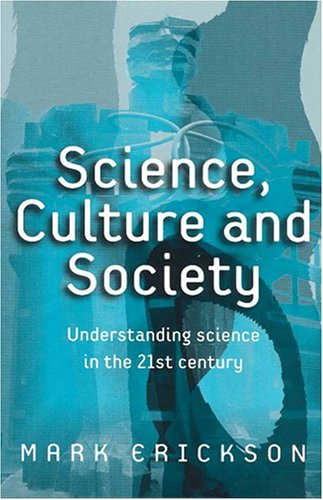Science, Culture, and Society: Understanding Science in the Twenty-First Century
Erickson, Mark
Polity Press, Cambridge
2005
0745629741 (hb), 074562975X (pb)
 The 21st Century has seen the infiltration of science into all aspects of our lives. Recently there has been concern that the pace of change is moving too fast with science increasingly being questioned and amplified by feelings of fear and distrust. Examples of controversial science include human gene modification and nuclear energy, with concern focusing on potential future risks. This concern, coupled with the widespread perception that a crisis of confidence exists in science and technology in the UK and ongoing debates around public understanding of science, provides a backdrop for Science, Culture and Society.
The 21st Century has seen the infiltration of science into all aspects of our lives. Recently there has been concern that the pace of change is moving too fast with science increasingly being questioned and amplified by feelings of fear and distrust. Examples of controversial science include human gene modification and nuclear energy, with concern focusing on potential future risks. This concern, coupled with the widespread perception that a crisis of confidence exists in science and technology in the UK and ongoing debates around public understanding of science, provides a backdrop for Science, Culture and Society.
The aim of the book is to 'open up' science. Erickson wants to move away from the commonly upheld view that objective scientific methods produce hard facts, to a view that regards science as a complex social phenomenon resulting from social construction processes within a variety of different cultures of inquiry. The main thrust of the book is to question science and demonstrate the difficulty in producing one sole definition of its construction. Science is not confined to the laboratory, but is much more complex, with the production, transmission and reception of knowledge being conducted differently within different cultural contexts. Thus, science and scientific knowledge should not be seen as a one-way relationship in the 'hypodermic' sense, but a two-way relationship between science and society, with different cultural contexts being the mediating factor.
The text provides insight into why science is so important, how it is defined, how science is structured and the ways it produces knowledge. The book is divided into four parts, which move from formal scientific practice to culturally-informed representations of science. Part I introduces the main contexts and theoretical frameworks that are used to try and understand science and outlines why science is difficult to define. Part II moves on to describe what people would identify as 'real' science and discusses how scientists produce and explain science in formal scientific ways. There is specific focus on laboratory work and the scientific knowledge it produces, the location of science and scientific knowledge in a historical context, and examination of scientists and scientific communities.
Part III moves away from the formal scientific cultures and explores some of the more cultural informed resources for the social construction of science. Focus is centred on popular science in contemporary culture, with a consideration of texts produced for non-scientists, by scientists or those with a strong scientific background. Erickson makes reference to the large numbers of scientific books, which have the dual purpose of both informing and entertaining. This is then followed with a discussion of the importance of science fiction and how this is embedded within popular culture. By including examples such as the X Files, Star Trek and the Hulk, it is demonstrated how the purpose of science fiction at a general level is to reinforce societal attitudes towards science. The final part of the book aims to pull together the dominant themes and offers ideas and possible strategies for culturally informed research in the future. The author does this by focusing on the emerging novel and controversial research area of nanotechnology.
The book is 241 pages in length, and whilst it does meet its aim of outlining scientific practice followed by a discussion of the role of society in the social construction of science, it does this at a very general level. For this reason it is an appropriate text for undergraduate students, particularly those within cultural studies and sociology. Also, as the book aims to locate the importance of science across a range of disciplines it is suitable for those with a general interest in science and technology or those that want to understand how science fits in with contemporary culture. There are a number of additional features that are useful. The end of each chapter has extensive suggested further reading and there are notes of other places to visit for further information. There are also thought provoking quotations and a number of interesting illustrations throughout the text.
In conclusion, this is a timely introductory text that is comprehensive and well written. The text specifically focuses on the social construction of science, arguing that the relationship between science and society is reciprocal and science is not something that is 'done to' society. As Erickson states, we need to 'stop regarding science as a separate part of society, and instead see the boundaries of science and the boundaries of society as inseparable and conterminous' (p5).
Victoria Simpson
University of Salford

